What does past climate change tell us about global warming?
What the science says...
| Select a level... |
 Basic
Basic
|
 Intermediate
Intermediate
| |||
|
Greenhouse gasses, principally CO2, have controlled most ancient climate changes. This time around humans are the cause, mainly by our CO2 emissions. |
|||||
Climate Myth...
Climate's changed before
Climate is always changing. We have had ice ages and warmer periods when alligators were found in Spitzbergen. Ice ages have occurred in a hundred thousand year cycle for the last 700 thousand years, and there have been previous periods that appear to have been warmer than the present despite CO2 levels being lower than they are now. More recently, we have had the medieval warm period and the little ice age. (Richard Lindzen)
At a glance
Just imagine for a moment. You fancy having a picnic tomorrow, or you're a farmer needing a dry day to harvest a ripe crop. So naturally, you tune in for a weather-forecast. But what you get is:
“Here is the weather forecast. There will be weather today and tomorrow. Good morning.”
That's a fat lot of use, isn't it? The same applies to, “the climate's changed before”. It's a useless statement. Why? Because it omits details. It doesn't tell you what happened.
Climate has indeed changed in the past with various impacts depending on the speed and type of that change. Such results have included everything from slow changes to ecosystems over millions of years - through to sudden mass-extinctions. Rapid climate change, of the type we're causing through our enormous carbon dioxide emissions, falls into the very dangerous camp. That's because the faster the change, the harder it is for nature to cope. We are part of nature so if it goes down, it takes us with it.
So anyone who dismissively tells you, “the climate has always changed”, either does not know what they are talking about or they are deliberately trying to mislead you.
Please use this form to provide feedback about this new "At a glance" section. Read a more technical version below or dig deeper via the tabs above!
Further Details
Past changes in climate, for which hard evidence is preserved throughout the geological record, have had a number of drivers usually acting in combination. Plate tectonics and volcanism, perturbations in Earth's slow carbon cycle and cyclic changes in Earth's orbit have all played their part. The orbital changes, described by the Milankovitch Cycles, are sufficient to initiate the flips from glacials (when ice-sheets spread over much of Northern Europe and the North American continent) to interglacials (conditions like the past few thousand years) and back – but only with assistance from other climate feedbacks.
The key driver that forces the climate from Hothouse to Icehouse and back is instead the slow carbon cycle. The slow carbon cycle can be regarded as Earth's thermostat. It involves the movement of carbon between vast geological reservoirs and Earth's atmosphere. Reservoirs include the fossil fuels (coal/oil/gas) and limestone (made up of calcium carbonate). They can store the carbon safely over tens of millions of years or more. But such storage systems can be disturbed.
Carbon can be released from such geological reservoirs by a variety of processes. If rocks are uplifted to form mountain ranges, erosion occurs and the rocks are broken down. Metamorphism – changes inflicted on rocks due to high temperatures and pressures – causes some minerals to chemically break down. New minerals are formed but the carbon may be released. Plate tectonic movements are also associated with volcanism that releases carbon from deep inside Earth's mantle. Today it is estimated by the U.S. Geological Survey that the world's volcanoes release between 180 and 440 million tonnes of carbon dioxide per year - as opposed to the ~35 billion tonnes we release.
Epic carbon releases in the geological past
An extreme carbon-releasing mechanism can occur when magma invades a sedimentary basin containing extensive deposits of fossil fuels. Fortunately, this is an infrequent phenomenon. But it has nevertheless happened at times, including an episode 250 million years ago at the end of the Permian Period. In what is now known as Siberia, a vast volcanic plumbing-system became established, within a large sedimentary basin. Strata spanning hundreds of millions of years filled that basin, including many large coal, oil, gas and salt deposits. The copious rising magma encountered these deposits and quite literally cooked them (fig. 1).
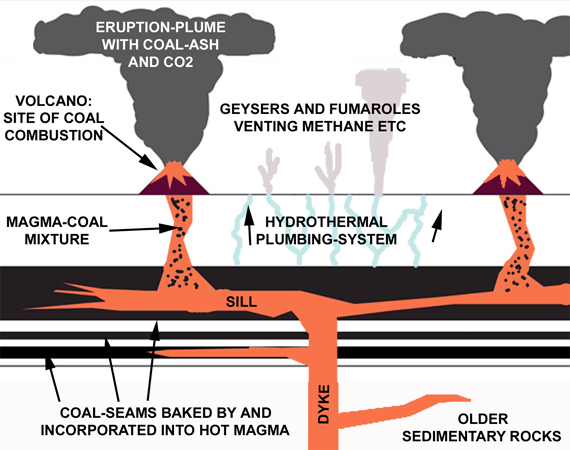
Fig. 1: schematic cross section though just a part of the Siberian Traps Large Igneous Province, showing what science has determined was going on back then, at the end of the Permian Period.
Now laden with a heavy payload of gases, boiled out of the fossil fuel deposits, some of the magma carried on up to the surface to be erupted on a massive scale. The eruptions – volcanism on a scale Mankind has never witnessed - produced lavas that cover an area hundreds of kilometres across. Known as the Siberian Traps, because of the distinctive stepped landforms produced by the multiple flows, it has been calculated that the eruptions produced at least three million cubic kilometres of volcanic products. Just for a moment think of Mount St Helens and its cataclysmic May 1980 eruption, captured on film. How many cubic kilometres with that one? Less than ten.
Recently, geologists working in this part of Siberia have found and documented numerous masses of part-combusted coal entrapped in the lavas (Elkins-Tanton et al. 2020; fig. 2). In the same district are abundant mineral deposits formed in large pipes of shattered rock as the boiling waters and gases were driven upwards by the heat from the magma.
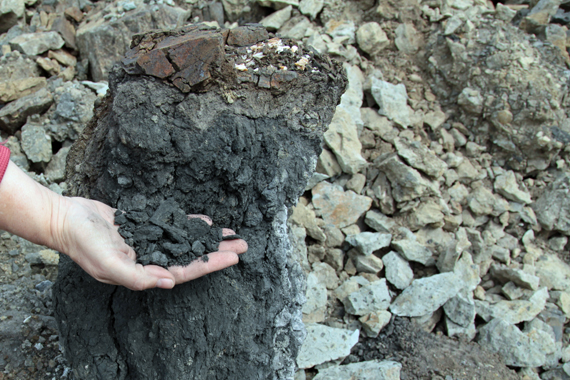
Fig. 2: an end-Permian smoking gun? One of countless masses of part-combusted coal enclosed by basalt of the Siberian Traps. Photo: Scott Simper, courtesy of Lindy Elkins-Tanton.
It has been calculated that as a consequence of the Siberian Traps eruptions, between ten trillion and one hundred trillion tons of carbon dioxide were released to the atmosphere over just a few tens of thousands of years. The estimated CO2 emission-rate ranges between 500 and 5000 billion tonnes per century. Pollution from the Siberian Traps eruptions caused rapid global warming and the greatest mass-extinction in the fossil record (Burgess et al, 2017). There are multiple lines of hard geological evidence to support that statement.
We simply break into those ancient carbon reservoirs via opencast or underground mines and oil/gas wells. Through such infrastructure, the ancient carbon is extracted and burned. At what rate? Our current carbon dioxide emissions are not dissimilar to the estimated range for the Siberian Traps eruptions, at more than 3,000 billion tons per century. The warning could not be more clear. Those telling you the climate's changed before are omitting the critical bit – the details. And when you look at the details, it's not always a pretty sight.
Last updated on 14 February 2023 by John Mason. View Archives































 Arguments
Arguments










































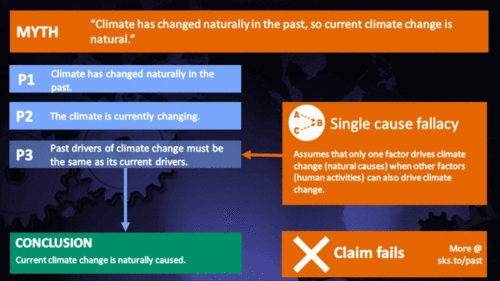





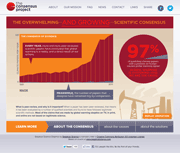
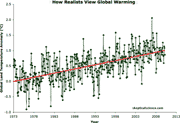
Re - #899: there's a post in the publication-queue regarding Bolling-Allerod events - not sure as to publication-date, but the points made by Eclectic at #900 are relevant. They are regional in their extent.
All of the fear mongering about Humans changing the climate never discuss the fact the the climate changed dramatically in the last 880ka.
The Younger Dyras Impact event was AFTER the climate had warmer dramatically.
Every scientist FUNDED talks about the oceans rising 300 feet when in the past there has NEVER been an ocean level above 20m from present and most are less than 8m.
There have been 16 cataclysms that could have easily destroyed advanced civilizations, we have also had a pair of "nuclear Winters" in the last 250 years.
We might be able to track asteroids but Younger Dryas appears to be a comet impact.
The earth has had higher levels of CO2 before are we so omniscient to know Our CO2 is the end of mankind. <yes, I have heard this bit of fear mongering from scientists).
I would like to knwo WHY the temperatures changed so dramatically on what appears to be a fairly regular but NOT in sync with any astronomical- earth wobble et al.
The impact event appears to have killed the large fauna in NA, spread a layer of ash, ended Clovis, and we do have all this troubling evidence of advanced and large populations in SA.
Fossil Fuels are made from life forms that used to be on the surface.
Exactly why should they not be brought up and put back into the mix?
I am a major skeptic of what is looking like fear-mongering science.
[PS] Well you have come to the right place to find answers but you will have to spend some time actually reading the science to understand them. Please take the time to do so. Also please make a careful study of the comments policy. It is not optional.
Your position appears to be that climate has changed before, we dont know why, so we can ignore all the actual measurements of the effects of increasing CO2 on temperature. If you want to argue that, then you must provide evidence to support your assertions. eg. what evidence convinced you that milankovich forcing have not driven previous ice ages.
However, you could save everyone a lot of time if you spent just a little bit of time reading the summary of what the consensus science actually is in the IPCC reports. It always good to know exactly what you are arguing against as opposed to some strawman version of it that you read on some deniers website.
Brainscientist @902 :
You can find a vast amount of information and analysis at this SkepticalScience website, if you like reading for self-education.
For instance, the world temperatures (per proxy) show no evidence of the 'pair of "nuclear Winters" [sic]' that you mention occurring 'in the last 250 years' [unquote]. Perhaps you got that from a very unreliable source.
# Now, there have been some slight "dips" in world temperatures during the last 600 years ~ apparently caused by a combination of clusters of volcanic eruptions plus some Grand Solar Minima . . . but even these "dips" have been (globally) less than 0.5 degreesC. And even at the height of the USA/USSR Cold War panics, no-one much was afraid at the thought of a post-apocalyptic Nuclear Winter chilling effect of less than 0.5 degreesC.
And if you don't like reading but prefer viewing , then you can get a bigly amount of education by viewing the YouTuber "potholer54" who has a climate series of short videos (total 71 videos currently) that are both easy-going and mildly humorously presented. You will enjoy them, I'm sure ~ as they educate by debunking many of the absurd unscientific memes which the science-deniers so often recycle.
You will also be amused by the videos' Comments sections, where some protesters (against climate science) bring up some bigly moronic assertions. One of the most recent of these, in past months, has been commenter "OldScientist" who often copies-and-pastes his own comments. He is quite clueless about science and logic. But he is entertaining ~ if you enjoy Schadenfreude.
[BL]
As an FYI, here is a link to Potholer54's Youtube channel.
Brainscientist @ 902:
As pointed out by Eclectic in 903, and in the moderator's comment on your comment, there are many resources where you can find out more about the topics you opine on. Here at Skeptical Science, you are expected to provide some sort of reference to claims. Sadly, your comment is short on supporting information.
You can find much information here, using the Search function on the upper left of each page, or by looking at the many topics that are presented in the Most Used Climate Myths (also linked to in the upper left of each page).
You start with an empty assertion that people "...never discuss the fact the [sic] the climate changed dramatically in the last 880ka.". "Never" is an awfully strong assertion. You say that, in spite of the fact that the Intermiediate tab of the post you are responding to has a graphic (Original source Wikimedia) showing earth temperatures over the past 500 million years. Here is the graphic again:
Your claim of "never" is so easily refuted that it makes one wonder just what sources of information you have been using.
You also use the "never" word in your third paragraph, where you say "...when in the past there has NEVER been an ocean level above 20m from present and most are less than 8m." Again, let's make use of some graphics from Wikipedia, where there is a page on Past sea level. That page has the following graphic:
Your claim of "never" includes the 542 million year period covered in that graph - unless, of course, you have some sort of special meaning for "never". For most of us, the definition of "never" is probably similar to that found in Wiktionary: "At no time; on no occasion; in no circumstance."
FYI, the peak in that graphic (400m) is a wee bit higher than your claim of 20m. Unless you also have your own definition of the mathematical meaning of "above 20m".
Skeptical Science has a nice page on the Younger Dryas.
If you really, honestly "..would like to know why..." then (as Eclectic and the moderator have pointed out) you should start with some reading (or videos such as the Potholer ones Eclectic has mentioned). Whatever sources you have been looking at appear to have seriously led you astray.
...and when you make assertions about observations or analysis, then please provide some sort of references to the sources of the material you have used to inform your opinions. Without references, all you have is empty opinions.